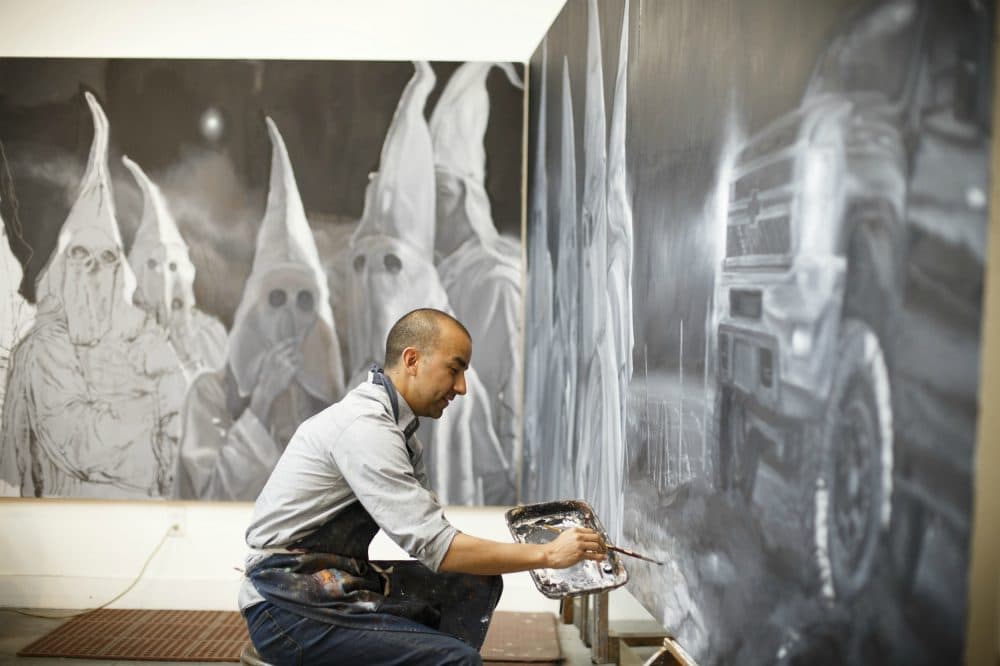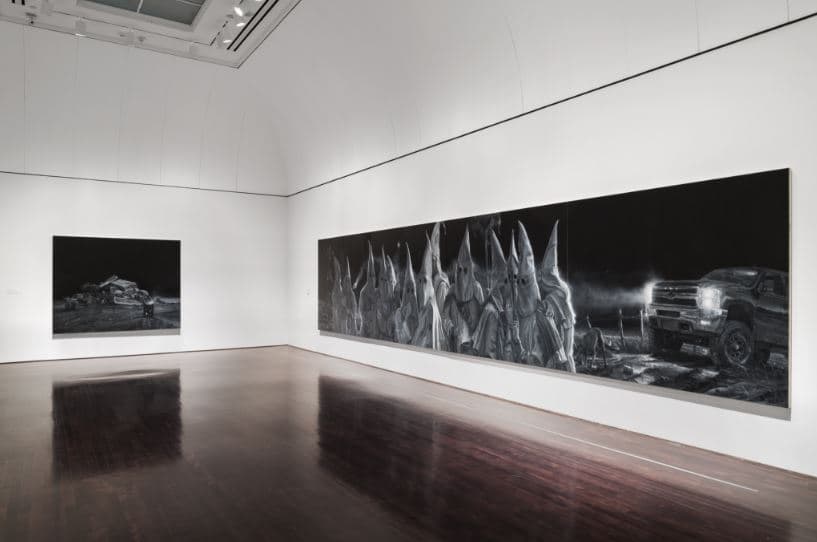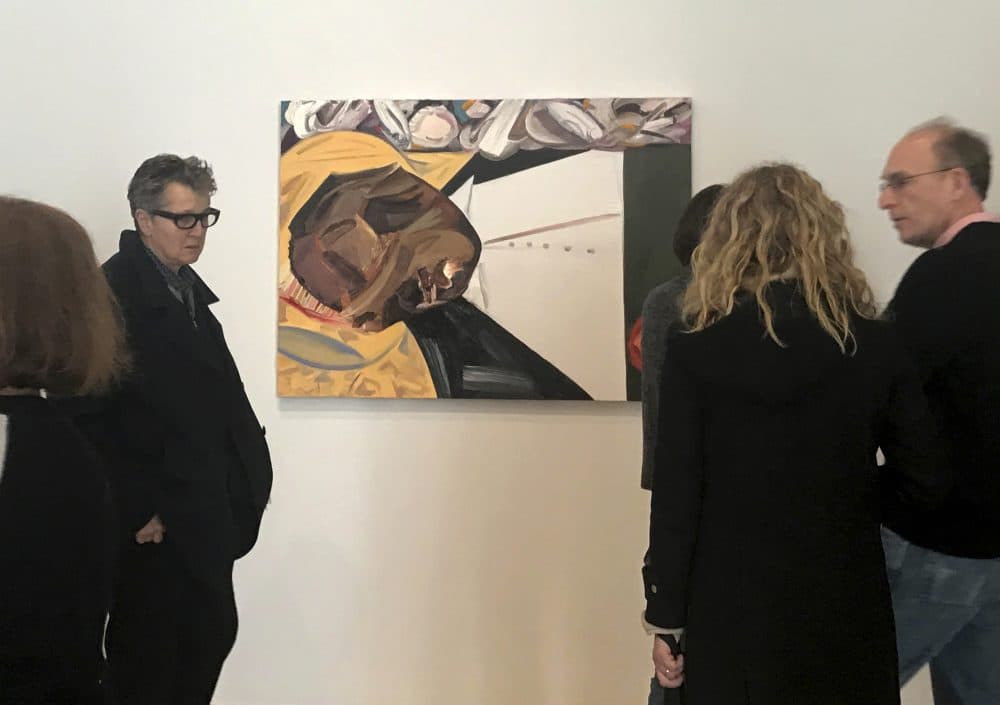Advertisement
Commentary
What’s 'Offensive' Art? The Answer Isn’t Black And White

The painting is eerie, almost indistinguishable from a black and white photograph. Standing on a bluff above a distant city is a nighttime gathering of hooded Ku Klux Klansmen, illuminated by the high beams of a Chevy Silverado truck. In the near background are the mundane artifacts of contemporary American life — a cell phone tower, a scattering of tires. Equally pedestrian, the Klansmen, who resemble hard-shelled insects more than humans, stare directly at the viewer or tightly huddle in conversation with each other. Some hold beer cans, some check their iPhones. One clutches a clipboard to her chest, another carries a small, hooded child in her arms. In these quotidian actions, we witness what Hannah Arendt famously described as “the banality of evil.”
At least that’s what some people see.
Others, including a University of Texas student who opposed the Blanton Museum’s acquisition and display of "The City I," find the painting a deeply offensive display of gratuitous racism.

“The image is not a critique of modern culture; it glamourizes historical violence by way of art world validation," the student wrote. " … It is a gratuitous grab for money and attention by the Museum and artist.”
Not only did this student object to its content and style, but also to the fact that the painter, Vincent Valdez, is not black. “The artist is Mexican American and while Mexicans experienced racism in the Western Hemisphere, the KKK historically terrorized and murdered African Americans to a larger extent.”
In an interview, Valdez was explicit about his intention, which was to expose the ubiquitous, respectable presence enjoyed by racists.
Valdez was explicit about his intention, which was to expose the ubiquitous, respectable presence enjoyed by racists.
“These individuals could be any Americans,” he said. “There is a false sense that these threats were, or are, contained at the peripheries of society and in small rural communities. . . It is possible that they are city politicians, police chiefs, parents, neighbors, community leaders, academics, church members, business owners, etcetera. This is the most frightening aspect of it all.”
But if a painting of Klansmen requires explanation, if, as the protesting students argue, “the intent of the artist does not always manifest itself in the artwork …” then do intentions matter? Or simply by virtue of depicting brutalizers, are these artists guilty of maintaining their hold on the public imagination? And by defending the artist’s right to free speech, are we implicitly endorsing the right to hate speech?
Certainly, those objecting to Dana Schutz’s abstract painting of Emmett Till at the 2017 Whitney Biennial, "Open Casket," were not assuaged by the artist’s explanation of her motivations. Schutz claimed that the painting was a reaction to the rising volume and acceptance of racial hate speech engendered by Donald Trump’s presidential campaign. And she responded to one of her most prominent critics, Hannah Black, by saying, “I don’t know what it is like to be black in America, but I do know what it is like to be a mother. Emmett was Mamie Till’s only son. The thought of anything happening to your child is beyond comprehension.”

But what Schutz may have intended as an expression of empathy and solidarity was experienced by at least some protesting black artists and viewers as the appropriation and commercialization of African-American suffering.
“She has nothing to say to the Black community about Black trauma," declared Parker Bright, who stood daily in front of the painting in a teeshirt on which he’d written the words, “Black Death Spectacle.”
So who is in the right here? Is Vincent Valdez building his reputation and enriching himself by glorifying the KKK, or is he exposing the myth of a post-racial society? Is Dana Schutz exploiting black suffering, or is she further honoring the wishes of Emmett Till’s mother — that her son’s savagely beaten body, swollen and defaced, be seen?
Who has the right to depict the suffering and oppression of others?
African-American artist Kara Walker — whose meticulous work depicting the grotesquery of slavery, lynching, and minstrel shows has also generated protest for perpetuating racist stereotypes — offered an answer in an Instagram post in response to the Dana Schautz controversy. “The history of painting is full of graphic violence and narratives that don't necessarily belong to the artist's own life …” she wrote. “…perhaps, when we are feeling generous we can ascribe the artist some human feeling, some empathy toward her subject.”
If we deny or constrain that empathetic impulse, we limit artists — and our own understanding — in ludicrous ways. We’d be forced to argue that Chinese artist Ai Weiwei should not depict the desperate peril of Syrian refugees. We’d dismiss Israeli artist Michal Rovner, who employs both Israeli and Palestinian masons in building new structures from stones taken from both dismantled or destroyed Israeli and Palestinian homes.
Of course when some of the Schutz’s other paintings sell at auction for close to half-a-million dollars, it’s understandable that her critics would argue that it’s disingenuous to take a color-blind view of the artist. After all, the business of art is still thoroughly grounded in privilege, dominated by wealthy, predominantly white collectors.
If we deny or constrain that empathetic impulse, we limit artists -- and our own understanding -- in ludicrous ways.
But that’s the issue we should be taking on. Historically disenfranchised artists should focus on challenging a commercial system that favors the already-privileged in terms of who gets to make, view, and own art, not be distracted by the easier but more destructive battle against their peers.
“Painting — and a lot of art often lasts longer than the controversies that greet it,” Kara Walker wrote. “I say this as a shout to every artist and artwork that gives rise to vocal outrage. Perhaps it too gives rise to deeper inquiries and better art.” And, as Emmett Till’s mother understood only too well, “It can only do this when it is seen.”
